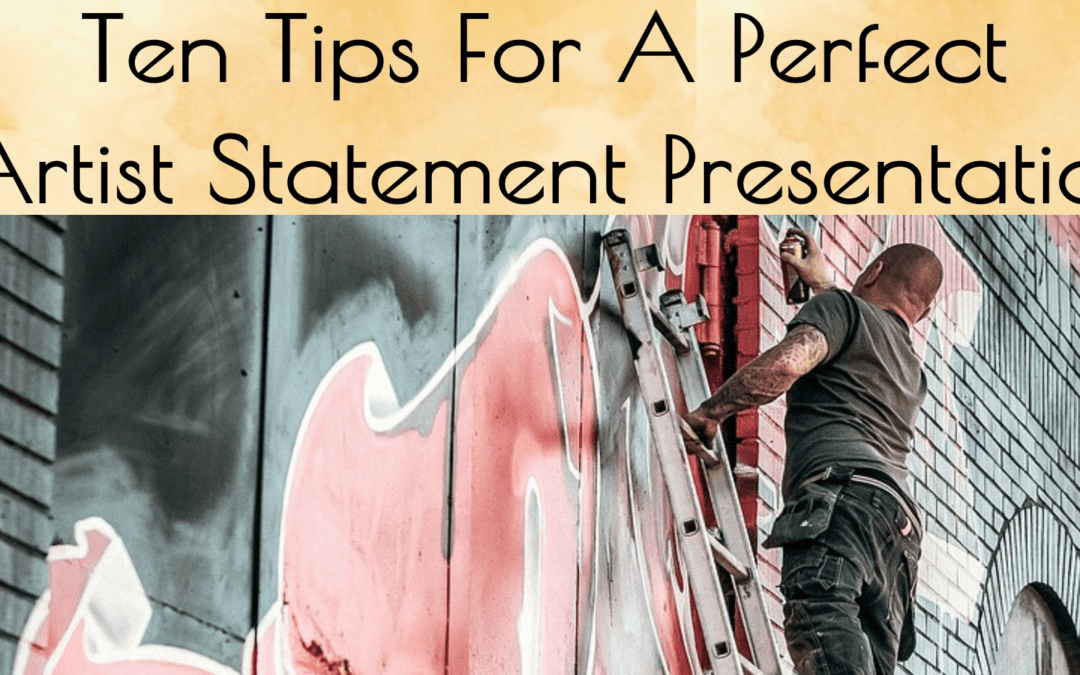
Ten Tips For A Perfect Artist Statement Presentation
Think about it, you’ve sweated blood writing your artist statement and now someone has asked for it. Will you be content to hand it over and that’s that? Or will you pay the same kind of attention to what happens next as you would before handing over a piece of your artwork?
Since the art patrons who see your artwork also see your statement, I’m guessing you want both to be presented with the same professional polish. Only, what does professional polish look like?
Even though your artist statement is smaller, percentage wise, then the sum total of your artwork, paying careful attention to the presentation details for each aspect of your art career reaps equal rewards.
Because, even if it is the last thing you want to put on your list, your presentation style sends out subliminal messages about you and your work. When you dismiss presentation details as unimportant or unessential, you lose a valuable opportunity to establish your influence and help shape the overall impact of how your work is viewed.
In an environment where we are all exhausted from the aesthetic bombardment of a 24/7 information platform, your audience needs all the help you can offer to appreciate what you do.
And if you’re aiming to impress a gallery owner, who already respects your artwork, executing this level of professionalism for your artist statement shows them how seriously you take your art career. It leads them to believe you will treat their relationship with you the same way that you show care for all that you do.
Gallery owners lead hectic lives; when you support what they are doing, you will be repaid by increased respect and attention from the gallery.
A Professional Presentation of Your Artist Statement: Ten Tips
Artist Statement Presentation Tip #1
Plan, Plan, Plan!
Start planning your artist statement presentation as soon as you know you have a show coming up. Why? You don’t want to get caught at the end if the unexpected strikes. This is the most common mistake artists make: they forget to schedule in some breathing room, ahead of time, for the inevitable, unforeseen event.
Artist Statement Presentation Tip #2
Ready (or not?)
Be sure to have your artist statement in tip-top shape before the presentation. This might seem like such an obvious tip that you can’t imagine why I’m including it. But a good number of artists forget to have their statement proof read by two or more readers, or critiqued by a professional writing consultant/editor who works with artists. Presenting a statement that isn’t ready to be presented is an exercise in futility, at best. An embarrassment at worst.

Artist Statement Presentation Tip #3
Details Matter
Design the physical presentation format with the same care that you give your artwork. Make a list of all the details that will make your artist statement shine: overall design, size, paper, font (style & size), mat, frame, display unit, etc.
Dropping a stack of 8×11.5 sheets of paper with a typed statement on some tabletop is worse than doing nothing at all. People will ignore it (as they should.) I know. I’ve been at shows and watched this in real time.
Artist Statement Presentation Tip #4
To Frame Or Not To Frame
Selecting the right design format for your artist statement is as critical as selecting the right display format for your artwork. The no-brainer option is to format your statement in the same way you do your work. Do you have a consistent mat, frame, or display for your pieces? Would this work for your artist statement?
Are there specific, unifying color themes throughout your work that could be carried over, say, in the paper, matting, or display unit? Is your artwork visually demanding or strong? Then make the visual presentation of your artist statement equally bold. Is your work subtle and quiet? Then be sure your statement stands out enough to be noticed, but not so much that it draws away from your work.
If your work can handle it, consider putting the statement in a contrasting format that highlights its presence, yet stays resonant with your pieces. Don’t be afraid to try unusual approaches, like a mobile. Play with different ideas and see which is the most striking. You want your statement to stand on its own, yet harmonize with the visual impact of your work.
Artist Statement Presentation Tip #5
The Graphic Design Of It All
Use a program like Canva to work out the graphic design details. The second most common mistake artists make is to ignore clean graphic design elements so it looks distinctive, yet uncluttered.
You’d be surprised how a simple detail, like selecting the perfect typeface to compliment your work, can raise your presentation to the next level.

Artist Statement Presentation Tip #6
Like Invisible Glue
Do not be tempted to overthink this, or make it a work of art. Reign in the urge to use more than one or two (at the most!) fonts for your statement: one font for the heading “Artist Statement” and another for the text that follows. Keep the focus on what you are writing.
Presentation should be like invisible glue, more noticed by what it doesn’t do than by what it does. Bold, italic, caps – all these, in one font, are quite enough to create any distinction you need or want.
Artist Statement Presentation Tip #7
Remember Your Reader
Another mistake is forgetting that what you’ve written will eventually be read. Paying attention to page layout will make all the difference between something that is easy to read, or frustrating to read.
First, be sure the font size is large enough to read comfortably. Then, space your statement in different ways to give visual breathing room.
Maybe three sentences then two lines of no text, then two more sentences, etc. When you do this, be sure to create a break in the text where there is a shift in your subject.
You don’t want to willy-nilly break lines just for the visual effect. Try spacing your words/lines in at least three different ways, with different font sizes. Print them out, and then put all three on the wall at once. You will immediately see which one is the most appealing.
Imagine you are in a room where other people are standing in front of you. If you crane your head around them, could you read it? Is it visually compelling enough to entice you to move closer? Remember, you really do want people to read this. Make it easy for them.
Artist Statement Presentation Tip #8
The Artist At Work
In addition to your artist statement, include one photograph, or a series, of “The Artist At Work.” Images of you working on your art are more compelling than the traditional book jacket photo. Here again, attention to detail counts.
A professional photographer can make all the difference in a photo that is engaging and one that is hard to see, or too small, or too big. Be sure the photo and the artist statement are designed to fit together. Put them in one display, or two complementary displays.
Artist Statement Presentation Tip #9
Displaying Your Artist Statement
Mounting your artist statement is an art in itself. You can design a mini-billboard with a separate stand. You can frame your statement as you would a painting or photograph. You can hang it in sections against the wall like a tapestry. You can create a mobile – just make sure it’s easy to read. You can have it in a box that people walk up to and flip a light switch to see inside.
One artist created an eight foot high whiteboard with 4” high letters that stood at the entry way to her show. It was elegant, clean, easy to read. Everyone stopped to read her artist statement before circling the room full of her work.
The only rules are: have it accessible and readable.
Since the artist statement is about name recognition – yours – you may want to do more than one display. This is a smart move if your show spans two or more rooms. Remember, the artist statement is not definitive; it is an evolving reflection on your work.
You may want more than one statement for different sections of your show, or different themes in your work. There’s no rule that says you can’t have more than one statement. That said, you need to pay attention to what might be too much.

Artist Statement Presentation Tip #10
The Artist Statement Mini-Version
Long after the hors d’oeuvres are gone, your statement can linger on. Gallery owners will love it if you give them more than your artist statement display: Create a mini-version of your statement and have it available for art patrons to pick up on their way out.
These can be stacked near the entrance/exit, placed on a pedestal display all their own, or in a pocket mounted on a wall near your work. Again, be sure any display mounting you choose is as lovely and carefully thought out as the statement itself. It only takes one careless, sloppy detail to infect the overall impact you want.
Artist Statement Presentation Bonus Tip #11
Wait…there’s more…
Printed on the reverse side of these smaller artist statements should be your contact information and anything else pertinent, such as “accepting commissions.”
If you include a photograph of one of your pieces, be sure it is spectacular. A poor visual reproduction hurts your work more than it helps. If you don’t want to, that’s okay too. People’s imaginations have a way of magnifying what they remember, so you’re in good shape either way.

P.S. Before presenting your artist statement, you have to write it.
No worries, I developed an easy process streamlined for artists.
Follow the guidelines in my definitive book on artist statements: Writing The Artist Statement: Revealing The True Spirit of Your Work — one easy chapter at a time.
Write it once, and you’ll have a system in place as your artwork evolves.

